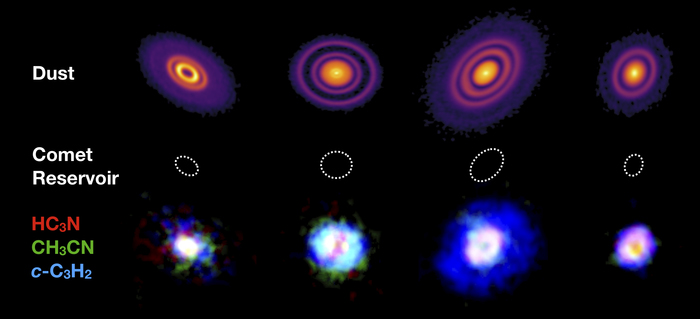Astrophysicists who set out to map the building blocks of life across space have found precursor molecules lurking in dust clouds destined to become future solar systems.
The discovery suggests Earth may not be so special, after all - many other worlds out there may have the same access to life-forming compounds that we have.
"The key result of this work shows that the same ingredients needed for seeding life on our planet are also found around other stars," says University of Leeds astrochemist, Catherine Walsh, who worked on the research.
"It is possible that the molecules that are needed to kick-start life on planets are readily available in all planet-forming environments."
For all of its splendid diversity, all life on Earth is built out of the same packet-mix recipe of organic molecules and minerals in lukewarm water.
Just how this soup of carbon-based chemistry took shape out of a small handful of elements that included hydrogen and nitrogen is a puzzle that's kept researchers busy for more than half a century.
Recent discoveries suggest Earth's primordial biochemistry could have been kick-started by processes among the stars, and even beyond, making it all too tempting to predict life should be common throughout the galaxy.
"However, many of the environments where we find these complex organic molecules are pretty far removed from where and when we think planets form," says John Ilee, an astrophysicist from the University of Leeds in the UK, who led the research.
"We wanted to understand more about where exactly, and how much of, these molecules were present in the birthplaces of planets – the protoplanetary disks."
Ilee led a team of astrophysicists from around the globe in mapping the location of a handful of prime precursors to biochemistry within distant clouds of dust and rock that will eventually settle into brand new solar systems.
It's one of those 'easier said than done' kind of tasks, relying on finding protoplanetary disks that aren't just close enough to analyze, but angled in such a way their entire disk of swirling material can be seen in all its glory.
Using the Atacama Large Millimeter/submillimeter Array (ALMA) in the Atacama Desert of northern Chile, Ilee and his team gathered light from a number of protoplanetary disks in search of the spectral signatures of various organic molecules.
In one study, the researchers studied the ratio of two significant organic compounds, cyanide and hydrogen cyanide.
Ironically for such a toxic substance, hydrogen cyanide is considered to be a primordial source of the carbon and nitrogen in life-generating chemistry. Measuring its concentrations in the mist of material surrounding a newborn star can help scientists get a better idea of interactions between the star's radiation and distribution of this potentially important ingredient.
Moving up the chain of complexity, the scientists also charted the distributions of three chunkier molecules within five protoplanetary disks.
These compounds – cyanoacetylene (HC3N), acetonitrile (CH ₃CN), and cyclopropenylidene (c-C3H2) – have been found in our Solar System before, as well as more distant planet-forming disks.
Mapping out their densities and distributions allows us to say with confidence the reservoirs of organic material in emerging solar systems echo are more or less like those in our own.
 The bottom images show the presence of each molecule in the protoplanetary disks. (J Ilee/University of Leeds)
The bottom images show the presence of each molecule in the protoplanetary disks. (J Ilee/University of Leeds)
The spectral fingerprints of these particular precursor molecules (above) suggests they tend to be concentrated in the inner regions of the planet-forming disks. What's more, their abundances are up to 100 times higher than current models predict.
Putting it another way, that packet-mix of organic dust that created life with just a dash of water on Earth isn't all that special.
Of course, it takes more than fertile soil for life to blossom. Some kind of fluid solvent, such as water, helps. As does respite from the blistering radiation blowing from a raging nearby star.
But given how many stars there are in our galaxy alone that could harbor planets with the benign conditions necessary to foster evolving chemistry, it's comforting to know their mud probably has all the building blocks it needs to have a good shot at getting life started.
This research has been accepted for publication in Astrophysical Journal Supplement Series, and is available for review on the preprint server arXiv.org.
#Space | https://sciencespies.com/space/building-blocks-for-life-have-been-found-within-planet-forming-dust-clouds/
No comments:
Post a Comment